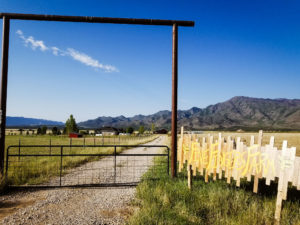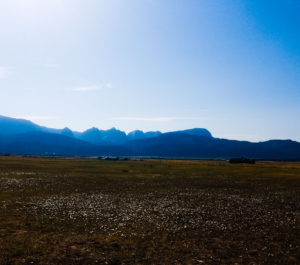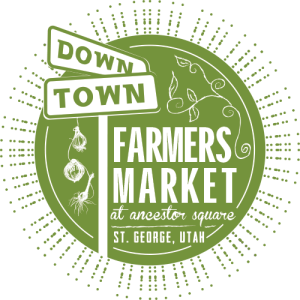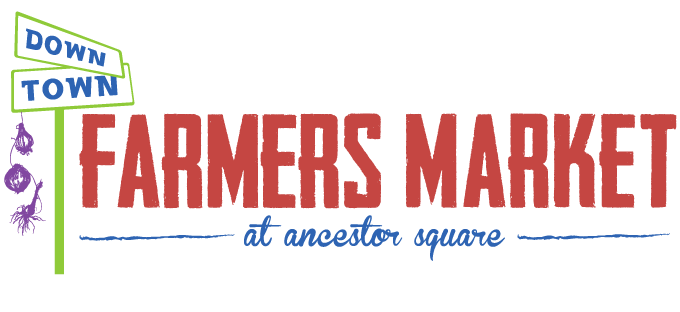Laine Gabrielsen of Five Fingers Farm
When you get involved in community-oriented events, you start seeing how intertwined the community really is. Everyone knows somebody who knows somebody who makes something and so on. It’s not uncommon for artisans or farmers to recommend people to me saying things like, “You should call them, they do (insert something random and amazing here).” So, when one of our talented art vendors, Hannah Gabrielsen, asked if her sister could sell baked goods, I wasn’t surprised and was more than happy to oblige. However, what did catch me off guard was when Laine Gabrielsen, the younger sister, showed up with a full-blown farm set up slinging eggs, fresh chickens, onions, sourdough goodies, and a sign heralding tours of their farm. I walked up to the booth, “Wow, so you’re a farmer not just a baker! You do tours?” Laine smiled and nodded. Hannah chimed in, “You should see the farm sometime. It’s literally the happiest place on earth. She has goats.” I laughed but set a reminder in my phone to schedule a visit to New Harmony. Over two months later, I finally got a chance to visit Five Fingers Farm and it was worth every second of the 40-minute northbound journey on the I-15. I pulled up to the beautiful hand painted sign and unlatched the gate. As I drove up the gravel road, I could see Laine’s silhouette waiting for me at the end of the driveway next to what looked like a huge white boulder. When I got closer, I realized the boulder was a gigantic white dog. As I opened my car door, the great white beast met me face to face. “Hi!” Laine piped, “This is Murphy. Just push him aside.” Murphy, a Great Pyrenees-Newfoundland mix, did not move until he received his mandatory hello snuggles then quickly circled back to Laine’s side; a post he maintained for the duration of my visit.

The Farm
Laine, Murphy, and I began to stroll around the farm. “Have you lived here your whole life? How’d you end up in New Harmony?” I asked anxiously. “My mom grew up gardening and my parents (Todd and Liz Gabrielsen) moved all over California, then to Salt Lake and about 10 years ago my mom just really wanted to move back to a small town and work the land. They began looking and found this place.” Nine years ago, the property was in foreclosure, had only a house on it, and was filled with junk. “Every oil change the man ever made was sitting in buckets out back,” Laine said, pointing to a patch of land near where the present day greenhouses are. “On top of all the physical trash we had to remove, the soil showed every sign of erosion and overgrazing. Our main focus since then has been to rebuild the soil. If the soil is healthy, everything else is.” I would soon realize how serious she was. Everything at Five Fingers Farm is about soil.
We meandered down the green, open path that led down to the various pens of livestock. Hens, Guinea fowl, and roosters all paraded before us, moving in glistening feather ripples down the lawn and clucking in their various dialects. It was difficult not to start daydreaming about living there. “So, these guys just run around all the time?” I said, gesturing at the menagerie of birds in front of me. “Yep!” Laine answered, “All of our birds are free range. They play a huge part in rebuilding the soil,” She went into a deep breakdown of the biochemical makeup of chicken poop and how it’s good for immediate pasture use but needs to be broken down for garden use. “We also look at them as the clean-up crew. They will come in and get rid of pests and prevent a lot of diseases from spreading… Also, they’re just happier and healthier running around.” Laine smiled. I asked if they were organic. “For us organic isn’t the end all be all. I mean, there are chemicals we won’t spray, but for me to feed them organic I’d have to have it shipped in across the country and by that time the carbon footprint alone isn’t worth it. It’s our belief that local is better.” I wanted to bow to her but thought that would make it weird, yes local is better, I echoed in my mind. “The chickens live the way they were meant to live, we feed them what they’re supposed to eat, no soy, from a local supplier that we like. I think that’s good enough.” Behind me was a stainless-steel table that Laine pointed at matter-of-factly, “This is where we do the slaughtering, we’re all open air which keeps it super clean.” She explained that they had learned how to process their own birds from a New Harmony old timer and were committed to growing the operation but still doing it right. I was a little stunned. No smell, no stains, no waste. Just a calm red barn and a beautiful morning.
I stood and stared at the beautiful red barn for a minute, wondering if it was for events or for actual use. Almost as if she read my mind, Laine pointed at the barn telling me about how it was, in fact, used for animals in the winter, and that it too played a part in rebuilding the soil. “We use the manure as fertilizer, but instead of mucking out the stalls and breaking our backs every day, we do what’s called deep bedding.” First, they put out straw and when the animals have done their business to the point of needing new straw, they scatter grain across it, then start over. “When it needs to be turned, we let the pigs in there and they’ll turn it looking for the grain.” Almost as if on cue, the pigs in front of us started squealing for our attention. “Ah, the pigs!” Laine said, as we got a little closer to the raucous pair, “You see how their snout curls up right there? It makes a perfect little shovel. We also move them around to different areas of the farm and they turn the soil for us.” The back portion of their pen had been expertly tilled in huge rows. “I mean we could buy a tiller and do it ourselves but this way we get bacon out of it,” Laine shrugged. I couldn’t help but giggle, “Bacon is good.” The two pigs, sourced from Ivins, bounced along the fence squeaking their side of the story. It was all I could do to resist reaching in the pen and ruffling them like puppies. “Be careful they bite,” Laine stated. I kept my hands to myself.

The pigs. chickens running a muck, and the glorious Bucket the Buck.
As we turned, we were met with the greenhouses and Bucket, their buck goat. “Almost all our animals are named after Shakespeare characters,” chimed Laine, as she made the introduction. I asked Bucket to smile for me and snapped a quick picture. As Bucket and I sat there ogling each other, Laine walked me through the history of how they went from dairy cows to goats. She explained that they had better luck processing it, but there were some failed experiments. I must admit, at this point we were less than half way done with our farm tour and I was flabbergasted by Laine’s knowledge and commitment to the farm. I felt a little jealous of the fact that she’s found her calling so young but simultaneously felt super grateful to her for sharing her passion. We left Bucket and headed to the two greenhouses behind him. I asked if they were store bought or custom. “These are custom built by a friend of ours. We told him that we wanted greenhouses and he said that he had figured out a design that could withstand the winds that come through here. So, we put them in and they’ve been perfect!” She cracked the door and my jaw dropped as we were greeted by a tomato forest. “Holy crap!” I exclaimed as I stepped in. “Ya, they love it in here!” Laine smiled. I learned that most diseases that affect tomatoes are wind born so the greenhouse keeps them protected. It also plays a huge part in keeping them safe from the farm’s grasshopper invasion, which had wiped out several plots already. We moved to the next greenhouse. “This is our Fall greenhouse, so we’ve just planted it.” There were different crops of arugula, spinach, beets, and cabbage. “Do you guys live off of what you grow on the farm?” I asked. “Probably about 40- 50% of what we eat comes from the farm, but I would say 75% of what we eat is local. We like to support our other local farms too.”

the view of the Five Fingers
We stepped out of the greenhouse into the mid-morning sun, where we were rejoined by Murphy, and began to walk around the pasture. As I followed Laine, she started pointing out the water drainage patterns on the property. She showed me the berms they had built to keep the water from flowing straight off the property. I asked them if they had water rights, acting like I had a clue what I was talking about. “Yes we do, but wells are notorious for going dry around here. That’s why it’s so important to have good soil. If the soil is good, it will hold the water. If it’s not, the water just runs off.” As I trailed behind her she would point to little things around us, saying phrases like, “Do you see that? That’s a good sign!” and “Look! That wasn’t like that a year ago.” When we turned to start heading up to the orchard, I looked up, “WOW.” The Five Fingers of Kolob were glistening in the sun. “Ya, it’s beautiful.” Laine sighed. “Is that where the name comes from?” I asked. “It’s one of the reasons,” Laine answered, “There are also five of us in the family and my mom wanted us to know that there is no shame in working the land with your hands.” Beautiful, I thought. She unhinged the gate in front of us, and Laine, Murphy, and I walked through into the orchard filled with grapes, peaches, and apples. The grasshoppers had left their mark here too. The apple trees were full of fruit but missing all their leaves. I pointed to a brand-new structure being built and asked if they were putting in a tiny home. “No, my brother is building a shed, but we are totally inspired and want to build a tiny house next,” Laine laughed.
Here, we crossed the lilac hedgerow into the huge garden, which quickly became my favorite spot on the property. Beautiful, lush, green foliage cascaded out of every raised bed. Tall, healthy rows of plants trailed down one side. Laine pointed out that in this area they practice no till gardening. The reason why is to preserve the fungi systems that run through the soil, making it easier for the plants to get the nutrients they need. We walked through the rows of gigantic squash and other plants to the bench swing, “Ah, this is my favorite spot!” Laine exclaimed, “Every farm needs a spot where you can sit down and look out and enjoy your hard work.” She sat down and began to swing, smiling completely content. We traded spots and I realized that Laine’s sister really was telling the truth: Five Fingers Farm really is the happiest place on earth. It would make everything worth it to be able to sit down every evening to that view. As we started down the rows, Laine started sharing her favorite fermenting recipes for beans and cucumbers. We came upon the cinderblock root cellar her dad put in and Laine mapped out what she hoped would be a future berry bramble. As we approached the house, Liz was out and about with a basket of fresh vegetables. She was wonderful and excited and insisted I take a loaf of bread and some tomatoes. Two things I never turned down.

clockwise from the left” Laine in the Fall greenhouse, tomato forrest, apple trees with no leaves, and some of the garden
I began my long drive home with my car filled with the scent of fresh bread and admiration for Laine and her family. I ran through all the projects they had going and all the work the 20-acre farm takes and how it truly is a family effort and a life’s work. I left the farm feeling like I had a better understanding of life in general and couldn’t wait for Saturday to buy one of Laine’s chickens. Laine sells most Saturdays at the Downtown Farmer’s Market at Ancestor Square and you can follow her on Instagram HERE, be sure to reach out and schedule your own tour!

